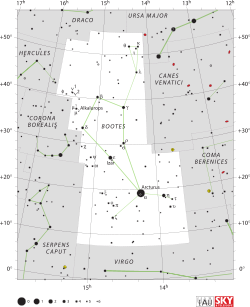Mu2 Boötis
Appearance
(Redirected from Μ2 Boötis)
Mu2 Boötis is a binary star in the northern constellation of Boötes. Its name is a Bayer designation that is Latinized from μ2 Boötis, and abbreviated Mu2 Boo or μ2 Boo. Based on parallax measurements, these stars are located at a distance of approximately 120 light-years from the Sun.
The components of μ2 Boötis have apparent magnitudes of +7.0 and +7.6.[2] They have similar spectral types, F9V and G0V respectively, and complete one orbit about their common centre of mass every 260 years.[4]
The system μ1 Boötis is at a similar distance and share similar proper motions with μ2, but has a significantly different chemical composition, so they are not gravitationally bound.[4]
References
[edit]- ^ a b c d e f g h Vallenari, A.; et al. (Gaia collaboration) (2023). "Gaia Data Release 3. Summary of the content and survey properties". Astronomy and Astrophysics. 674: A1. arXiv:2208.00211. Bibcode:2023A&A...674A...1G. doi:10.1051/0004-6361/202243940. S2CID 244398875. Gaia DR3 record for this source at VizieR.
- ^ a b c Tokovinin, Andrei (2018-03-01). "The Updated Multiple Star Catalog". The Astrophysical Journal Supplement Series. 235 (1): 6. arXiv:1712.04750. Bibcode:2018ApJS..235....6T. doi:10.3847/1538-4365/aaa1a5. ISSN 0067-0049.
- ^ a b c d e f g h Vallenari, A.; et al. (Gaia collaboration) (2023). "Gaia Data Release 3. Summary of the content and survey properties". Astronomy and Astrophysics. 674: A1. arXiv:2208.00211. Bibcode:2023A&A...674A...1G. doi:10.1051/0004-6361/202243940. S2CID 244398875. Gaia DR3 record for this source at VizieR.
- ^ a b c d e f g h i j k l Kiyaeva, O. V.; et al. (November 2014). "The multiple system ADS 9626: A quadruple star or an encounter of two binaries?". Astronomy Reports. 58 (11): 835–848. Bibcode:2014ARep...58..835K. doi:10.1134/S106377291411002X. S2CID 122667185.
- ^ a b Johnson, H. L.; et al. (1966). "UBVRIJKL photometry of the bright stars". Communications of the Lunar and Planetary Laboratory. 4 (99): 99. Bibcode:1966CoLPL...4...99J.

